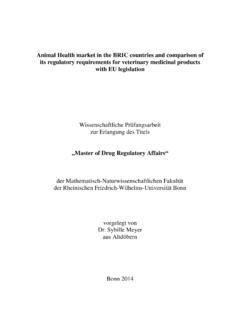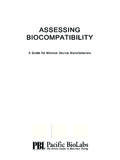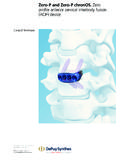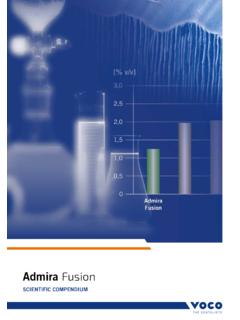Transcription of The new U.S. FDA regulations on biocompatibility …
1 The new FDA regulations on biocompatibility and reprocessing for medical devices Wissenschaftliche Pr fungsarbeit zur Erlangung des Titels Master of Drug Regulatory Affairs der Mathematisch-Naturwissenschaftlichen Fakult t der Rheinischen Friedrich-Wilhelms-Universit t Bonn vorgelegt von Anna Reifschneider aus Togliatti Bonn 2017 Page ii Betreuer und 1. Referent: Dr. Birka Lehmann 2. Referent: Dr. Ehrhard AnhaltPage iii Table of ContentsTable of Contents 1 List of Abbreviations .. vi 2 Introduction .. 1 3 The FDA regulations on premarket submissions ( , 510(k) and PMA) .. 3 4 Regulatory and quality failures have been the precursor for most FDA guidances .. 4 5 How the QSR affects biocompatibility , reprocessing, and sterilization.
2 7 6 biocompatibility .. 9 General .. 9 History of biocompatibility and the FDA .. 9 biocompatibility requirements for medical devices .. 10 General principles for biocompatibility testing on medical devices .. 10 Utilizing chemical characterization to complement biocompatibility 11 The FDA only approves complete devices, not specific raw materials .. 12 Minimizing the requirement of animal 14 The importance of risk analysis for biocompatibility testing .. 14 The importance of biocompatibility in medical device development .. 15 Effect of different materials on a device s 15 Changes on biocompatibility for a previously approved device .. 16 The role of FDA inspections on biocompatibility .. 17 Sterile barrier systems and biocompatibility considerations.
3 17 The potential regulatory consequences of changes to device materials .. 18 Using the results from a previous biocompatibility test .. 18 FDA requirements for shelf-life testing .. 19 biocompatibility and sterilization changes that require a new FDA submission .. 20 Effects of sterilization, cleaning, or disinfection on biocompatibility .. 20 Using new materials .. 21 Differences between the FDA-modified matrix and the ISO 10993 matrix .. 21 biocompatibility Evaluation Endpoints .. 22 Sample preparation .. 23 Test report requirements .. 23 7 biocompatibility test planning: safety evaluation of medical devices .. 24 General .. 24 What are the FDA prerequisites for biocompatibility testing? .. 24 Pre-assessment of device materials minimizes risk.
4 24 Testing materials versus a composite of the finished device .. 25 Conducting biocompatibility tests .. 25 Is GLP required for biocompatibility testing? .. 25 .. 26 Assurance .. 26 Page iv Table of Contents 8 Reprocessing .. 27 Background .. 27 The proper handling procedures for the reprocessing of reusable medical devices .. 27 FDA regulatory overview of the reprocessing process .. 28 The Olympus duodenoscope reprocessing scandal and its regulatory consequences .. 30 What happens if the method of reprocessing is changed .. 31 Devices that must validate their reprocessing methods .. 33 Factors to consider when performing validation testing on reusable devices .. 33 Acceptable reprocessing criteria for the FDA.
5 34 Focus on labeling comprehension .. 35 Usability and medical device reprocessing .. 35 How to conduct usability testing .. 36 How to validate the method of reprocessing .. 37 Cleaning validation .. 37 What is considered to be a worst-case condition .. 38 soil .. 39 sites .. 39 use environment .. 39 of worst-case conditions .. 39 Disinfection .. 40 disinfection .. 40 , thermal disinfection .. 40 , chemical disinfection .. 41 Sterilization .. 41 Flash Sterilization .. 42 Steam Sterilization .. 43 Gas Plasma (STERRAD) Sterilization .. 44 New FDA guidance on sterilization .. 45 9 FDA s Six Criteria for Reprocessing Instructions .. 47 Criterion 1 Labeling should reflect the intended use of the device.
6 47 Criterion 2 Users should thoroughly clean the device .. 47 Criterion 3 The appropriate microbicidal process should be provided .. 48 Devices .. 48 Devices .. 48 Devices .. 49 Criterion 4 Instructions should be technically feasible .. 49 Criterion 5 Reprocessing instructions should be comprehensive .. 49 equipment .. 50 wiping .. 50 and reassembly .. 50 solutions .. 50 Page v Table of Contents .. 51 .. Examination .. 51 for Disinfection/Sterilization .. 51 of any sterilant residuals .. 52 Life .. 52 Labeling Recommendations .. 53 Criterion 6 Reprocessing instructions should be understandable.. 53 10 Conclusion and outlook .. 54 11 Summary .. 55 12 Appendix A FDA warning letters for biocompatibility problems.
7 56 13 Appendix B FDA warning letters for reprocessing problems .. 57 14 Appendix C FDA warning letters for sterilization problems .. 58 15 Appendix D Devices that require validated reprocessing methods .. 59 16 60 17 Eidesstattliche Versicherung .. 61 18 References .. 62 List of Figures Figure 1: Percentage share of all class II submissions to the FDA by companies located in specific countries in Figure 2: Comparison between both versions of the Olympus 2 Figure 3: Illustration of the FDA guidance for mitigating the risk of cross-contamination in gastrointestinal List of Tables Table 1: List of major medical device problems that led to some of the newest FDA Page vi Section 1 List of Abbreviations 1 LIST OF ABBREVIATIONS510(k) AFSSAPS AAALAC AAMI AdvaMed ANSI ASTM CDC CEN CFR CDRH CGMP DHF DMR EO EPA FDA FFF GLP HCT ICDB IDE IFU ISO MDMA MDR MtF ODE OOS PETA PIP PMA QSR SAL SDO SOP TIR USC USP QAU *Note.
8 Because this paper focuses on the FDA, American English ( AmE ) will be submission made to the FDA for new & modified Class II devices Agence Fran aise de S curit Sanitaire des Produits de Sant Association for Assessment and Accreditation of Laboratory Animal Care Association for the Advancement of Medical Instrumentation Advanced Medical Technology Association American National Standards Institute American Society for Testing and Materials Centers for Disease Control European Committee for Standardization Code of Federal regulations Center for Devices and Radiological Health Current Good Manufacturing Practices Device Histroy File Device Master Records Ethylene Oxide Environmental Protection Agency Food and Drug Administration Final Finished Form Good Laboratory Practices Human
9 Cells, Tissues. Infection Control Devices Branch Investigational Device Exemption Instructions For Use ( , user s manual) International Organization for Standardization Medical Device Manufacturers Association Medical Device Reports Memo-to-File Office of Device Evaluation Out of Specification People for the Ethical Treatment of Animals Poly Implant Proth se Pre-Market Application made to the FDA for Class III devices Quality Systems regulations Sterility Assurance Level Standards Developing Standard Operating Procedures Technical Information Reports United States Code United States Pharmacopoeia Quality Assurance Unit Page 1 Section 2 Introduction 2 INTRODUCTION The United States is the biggest medical device market in the world, with a market size of approximately US$148 billion [1].
10 The share of the global marketplace value of the global medical device market in 2015 was approximately 43%. The Food and Drug Administration ( FDA ) controls access to this market. In one study that was sponsored by the Medical Device Manufacturers Association ( MDMA ), Stanford University researchers asked 204 medical technology companies about the regulatory process. The reported average cost to take a product from concept to market is US$31 million, and that roughly 77% of that amount is spent on tasks related to FDA regulation [2]. A major part of those costs involves issues of biocompatibility , reprocessing, and/or sterilization [ 3 ]. Therefore, it is clear that these three regulatory areas represent important topics for many medical device manufacturers [ 4].















